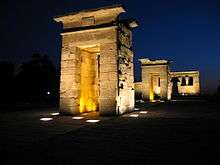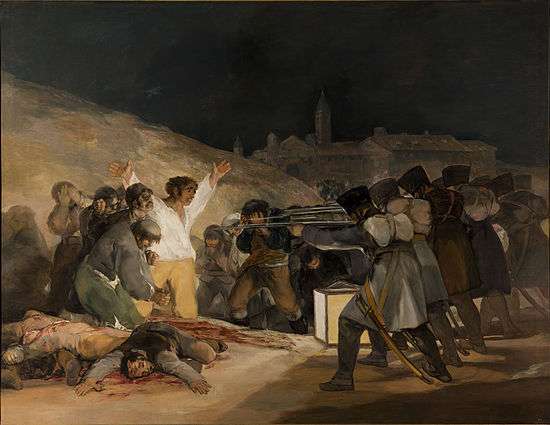Príncipe Pío (hill)


_02.jpg)
_L%C3%ADnea_10_de_metro_(3).jpg)
La montaña del Príncipe Pío is the name of a hill in the western part of Madrid, Spain.
It is named after prince Guillermo Pío de Saboya, a member of the Pio di Savoia family, whose wife Juana de Moura owned property there. Later, barracks (Cuartel de la Montaña) were constructed there. The Madrilene rebels who fought the Napoleonic invaders on 2 May 1808 were executed there on the morning of 3 May, as painted by Francisco de Goya.
Around the 1960s, the barracks were demolished to make room for the Parque del Oeste ("West Park"). The former location of the Barracks is now the site of the Temple of Debod, a Nubian temple given by the Egyptian government to Spain in gratitude for Spanish help in saving antiquities during the building of the Aswan Dam.
Station
Príncipe Pío is also the name of a commuter train station and travel interchange at the bottom of the hill near the San Vicente gate. Formerly known as Estación del Norte, it used to be an important interurban train terminal. The rail traffic is now primarily commuters on the RENFE cercanías network. It is also a metro station, serving lines 6, 10, and the Ramal (branch line) of the Madrid Metro. The Ramal is a point-to-point shuttle line which links Principe Pio with the station at Ópera. There is a bus station, which makes use of a tunnel network.
External links
- The executions on Principe Pio Hill by Francisco de Goya (in Spanish).
- The executions on Principe Pio Hill by Francisco de Goya (in English).
- History of the Station with old pictures. In Spanish.
- Tileworks in the Principe Pio Mountains. Painting by Carlos de Haes.
| Wikimedia Commons has media related to Estación de Príncipe Pío. |
Coordinates: 40°25′26″N 3°43′04″W / 40.4239°N 3.7178°W